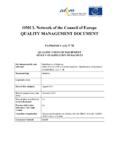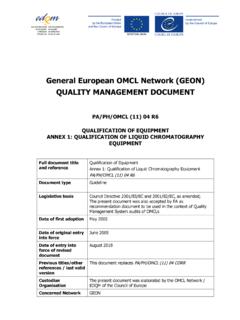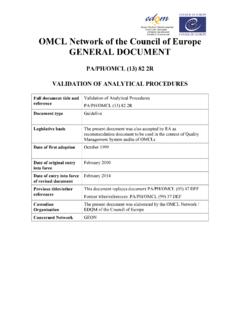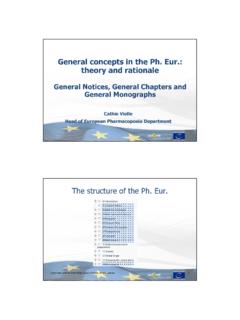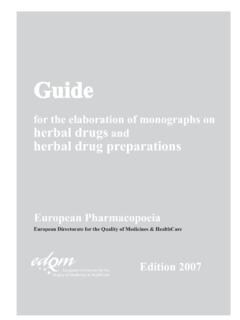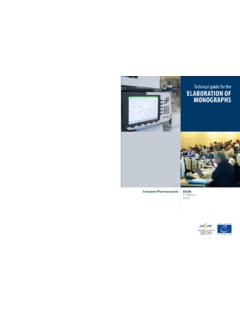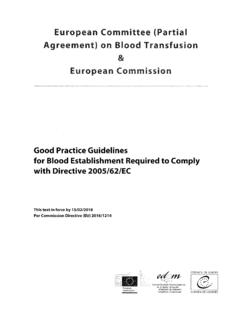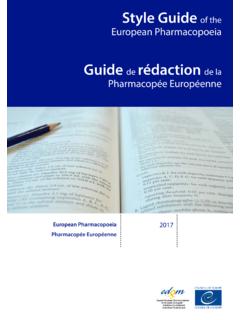Transcription of General European OMCL Network (GEON) QUALITY …
1 General European OMCL Network (GEON) QUALITY MANAGEMENT DOCUMENT PA/PH/OMCL (07) 108 R6 QUALIFICATION OF EQUIPMENT ANNEX 5: QUALIFICATION OF AUTOMATIC TITRATORS Full document title and reference Qualification of Equipment Annex 5: Qualification of automatic titrators PA/PH/OMCL (07) 108 R6 Document type Guideline Legislative basis Council Directive 2001/83/EC and 2001/82/EC, as amended Date of first adoption June 2008 Date of original entry into force August 2008 Date of entry into force of revised document 1st August 2016 Previous titles/other references / last valid version This document replaces document PA/PH/OMCL (07) 108 4R Custodian Organisation The present document was elaborated by the OMCL Network / EDQM of the Council of Europe Concerned Network GEON PA/PH/OMCL (07) 108 R6 - OMCL Guideline on automatic titrators (Annex 5)
2 Introduction The present document should be used in combination with the core document Qualification of Equipment when planning, performing and documenting the qualification process of automatic titrators. The core document contains the Introduction and General forms for Level I and II of qualification, which are common to all type of instruments. It is recommended, at Level II of qualification of the automatic titrators (Installation and release for use), to perform a gravimetric test (by selecting 10 volumes in a random way from 20 to 100% of the total volume of the cylinder used). The results should meet the specification provided by the manufacturer. The present annex contains instrument-related recommendations (parameters) to be verified at Level III and IV of qualification and the corresponding typical acceptance limits, as well as practical examples of the methodologies to be used.
3 PA/PH/OMCL (07) 108 R6 - OMCL Guideline on automatic titrators (Annex 5) TABLE III Level III. Periodic and motivated instrument checks Examples of requirements for automatic titrators 1. POTENTIOMETRIC TITRATORS (Ph. Eur. ) Parameter to be checked Typical tolerance limits Precision RSD Accuracy* drel % Linearity (optional) r2 *when a fresh commercial titrant is used 2. KARL FISCHER VOLUMETRIC TITRATORS used for semi-micro determination of water (Karl Fischer Titration, Ph. Eur. ) Parameter to be checked Typical tolerance limits Precision RSD % Recovery % to % Linearity (optional) r2 PA/PH/OMCL (07) 108 R6 - OMCL Guideline on automatic titrators (Annex 5) TABLE III (cont.) Level III. Periodic and motivated instrument checks Examples of requirements for automatic titrators (cont.)
4 3. KARL FISCHER COULOMETRIC TITRATORS used for micro determination of water (Coulometric Titration, Ph. Eur. ) Parameter to be checked Typical tolerance limits Precision Standard 1000 g/g H2O: RSD % Standard 100 g/g H2O: RSD % Recovery Standard 1000 g/g H2O: % to % Standard 100 g/g H2O: % to % Linearity (optional) r2 4. KARL FISCHER OVEN used for micro determination of water using an evaporation technique (Coulometric Titration, Ph. Eur. ) Parameter to be checked Typical tolerance limits Temperature accuracy C Temperature stability C Carrier gas flow rate 10 mL/min Precision RSD % Recovery % to %. PA/PH/OMCL (07) 108 R6 - OMCL Guideline on automatic titrators (Annex 5) TABLE IV Level IV. In-use instrument checks Examples of requirements for automatic titrators 1.
5 POTENTIOMETRIC TITRATORS Parameter to be checked Typical tolerance limits Precision RSD % Accuracy* drel % *when a fresh commercial titrant is used 2. KARL FISCHER VOLUMETRIC TITRATORS Parameter to be checked Typical tolerance limits Precision RSD % Recovery* % to % *in case amoxicillin trihydrate for performance verification CRS is used refer to the limits given in the accompanying Ph. Eur. leaflet 3. KARL FISCHER COULOMETRIC TITRATORS Parameter to be checked Typical tolerance limits Recovery Standard 1000 g/g H2O: % to %Standard 100 g/g H2O: % to % 4. KARL FISCHER OVEN used for micro determination of water using an evaporation technique (Coulometric Titration, Ph. Eur. ) Parameter to be checked Typical tolerance limits Recovery % to %.
6 PA/PH/OMCL (07) 108 R6 - OMCL Guideline on automatic titrators (Annex 5) ANNEX I Level III. Periodic and motivated instrument checks This Annex contains practical examples of parameters, methodologies and acceptance criteria related to the performance of automatic titrators. These examples can be considered by the OMCLs as possible approaches to perform the Level III of the equipment qualification process: Periodic and motivated instrument checks . General CONSIDERATIONS - Due to the fact that a holistic approach has been taken, the verification of temperature probes and burettes is not included in this guideline, as the performance of these items is indirectly checked during the accuracy test. - If available, the internal start-up test function may be used each time the instrument is switched on.
7 - If several exchange units are used for different titrants, all units should be tested at Level III. - The limits and specifications of this guideline have been set according to Metrohm documentation. For other manufacturers ( Mettler-Toledo, Mitsubishi, etc.) the parameters, methodologies and acceptance criteria may slightly differ. 1. POTENTIOMETRIC TITRATORS PRECISION Materials: Suitable certified material RV (highly pure, dried), Benzoic acid or Tris (hydroxymethyl)-aminomethane (TRIS) or other suitable for standardisation of the titrant to be used. Use appropriate titrant for the selected material (for instance M or M hydrochloric acid or sodium hydroxide or other suitable certified titrant). Method: Perform a minimum of 3 titrations with 3 independent additions of certified reference material which should result in a consumption of approx.
8 20 % to 90 % of the burette volume. Note: If necessary, for lower volume burettes, increase the molarity of the titrant (for example, from M to M) to minimize the weighing error. Calculate the relative standard deviation of the titers obtained. If available, this calculation can be performed directly with the built-in statistics function of the instrument. Report the results using a suitable report sheet, an example is provided in attachment 1. Limits: RSD % PA/PH/OMCL (07) 108 R6 - OMCL Guideline on automatic titrators (Annex 5) ACCURACY Applicable only using commercial fresh titrant. Materials: Refer to PRECISION. The accuracy of the results obtained depends on the content of the certified material guaranteed by its manufacturer.
9 Calculation of the theoretical titer value as a function of temperature: The theoretical titer value of the titrant solution at 20 C is , with a decrease of % per degree of temperature increase, according to the following formula: Titer theoretical (at X C) = + (20 X) Where: X C= mean of the initial and final temperature of the titrant solution (at the beginning and at the end of the measurement), in C. Note: The stated formula is only applicable for aqueous titrant solutions. As an example, the decrease of the titer of perchloric acid is % per degree of temperature variation. Method: Perform a minimum of 3 titrations with 3 different weights of certified material, which should result in a consumption of approx. 20 % to 90 % of the burette volume Note: Results from the precision test (see ) can be used.
10 Calculate the mean of the titers obtained. Calculate the systematic deviation (drel) with the following formula: 100titertitertiterdx ltheoreticaltheoreticameanrel If available, this calculation can be performed directly with the built-in statistics function of the instrument. Limits: The systematic deviation (drel) should be maximum % when a fresh commercial titrant is used LINEARITY Materials: Refer to PRECISION. Method: Linear regression volume/sample size Perform a minimum of 5 titrations with 5 different weights of certified material, which should result in a consumption of approx. 20 % to 90 % of the burette volume. PA/PH/OMCL (07) 108 R6 - OMCL Guideline on automatic titrators (Annex 5) Calculate a linear regression of the titrant volume in mL (y-coordinate), versus the sample size ( weight) of the certified material expressed in g (x-coordinate).

